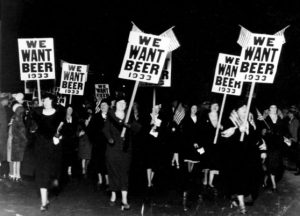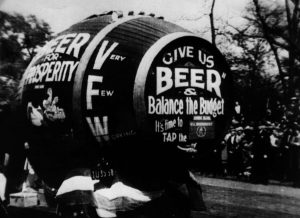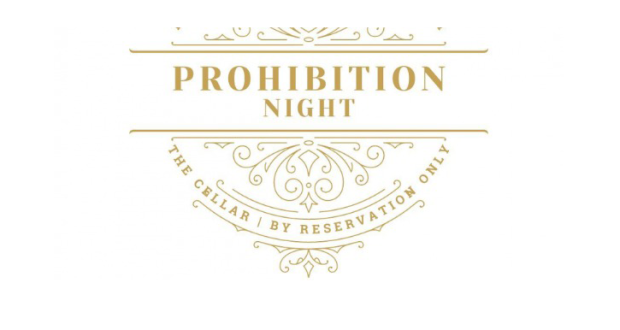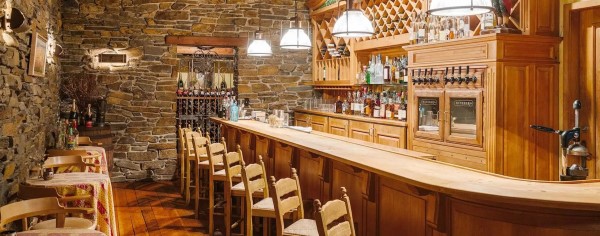OAKHURST — A “Prohibition-style” evening awaits you! The Cellar Bar, located at Château du Sureau in Oakhurst, will be transformed into a speakeasy where you can order specialty cocktails and soak up this unique atmosphere.
 With its stone clad walls and rich wood accents, the cozy Cellar Bar provides the perfect setting to enjoy classic cocktails and inventive beverages. An extensive wine list and lite fare menu enhances the experience.
With its stone clad walls and rich wood accents, the cozy Cellar Bar provides the perfect setting to enjoy classic cocktails and inventive beverages. An extensive wine list and lite fare menu enhances the experience.
Date & Time: Wednesday, March 15. Seatings at 5:00, 6:00, 7:00 and 8:00 p.m.
Click here for reservations.
Château du Sureau
9215 48688 Victoria Lane
Oakhurst, CA 93644
559-683-6860
A Brief History of Prohibition
 Prohibition was a period in the United States from 1920 to 1933 when the sale, manufacture, and transportation of alcoholic beverages were banned.
Prohibition was a period in the United States from 1920 to 1933 when the sale, manufacture, and transportation of alcoholic beverages were banned.
The movement towards prohibition had been growing for decades, as a response to the perceived social problems associated with alcohol consumption. The temperance movement, which advocated for the moderation or elimination of alcohol, had been around since the early 19th century.
 By the turn of the 20th century, it had grown into a powerful political force, with organizations such as the Women’s Christian Temperance Union (WCTU) and the Anti-Saloon League (ASL) lobbying for stricter alcohol laws. They argued that alcohol was responsible for a range of social ills, from poverty to domestic violence to political corruption.
By the turn of the 20th century, it had grown into a powerful political force, with organizations such as the Women’s Christian Temperance Union (WCTU) and the Anti-Saloon League (ASL) lobbying for stricter alcohol laws. They argued that alcohol was responsible for a range of social ills, from poverty to domestic violence to political corruption.
In 1917, the United States entered World War I, and the government sought to conserve resources for the war effort. The production of alcohol was seen as a waste of grain and other crops that could be used for food. President Woodrow Wilson declared that “the nation that drinks will be the nation that loses,” and the government began to restrict the production and sale of alcohol.
 In 1919, Congress passed the 18th Amendment to the Constitution, which prohibited “the manufacture, sale, or transportation of intoxicating liquors.” The Volstead Act, which defined what constituted an “intoxicating liquor,” was passed the following year. Prohibition went into effect on January 17, 1920.
In 1919, Congress passed the 18th Amendment to the Constitution, which prohibited “the manufacture, sale, or transportation of intoxicating liquors.” The Volstead Act, which defined what constituted an “intoxicating liquor,” was passed the following year. Prohibition went into effect on January 17, 1920.
At first, prohibition seemed to be a success. Alcohol consumption decreased dramatically, and many people who had been heavy drinkers gave up the habit entirely. However, prohibition also created a lucrative black market for alcohol, and organized crime quickly stepped in to fill the demand. Gangsters such as Al Capone and Bugs Moran made fortunes smuggling and selling illegal alcohol, and violence and corruption became rampant.
 The government struggled to enforce prohibition, as many people continued to drink and the illegal alcohol trade continued to thrive. Bootleggers and speakeasies, illegal establishments that served alcohol, became ubiquitous. Prohibition agents, also known as “dry agents,” were often corrupt or ineffective, and the public grew increasingly disillusioned with the law.
The government struggled to enforce prohibition, as many people continued to drink and the illegal alcohol trade continued to thrive. Bootleggers and speakeasies, illegal establishments that served alcohol, became ubiquitous. Prohibition agents, also known as “dry agents,” were often corrupt or ineffective, and the public grew increasingly disillusioned with the law.
In addition, prohibition had unintended consequences on the economy and society. The alcohol industry, which had been a significant source of jobs and tax revenue, was destroyed, and many people lost their livelihoods. The government also spent millions of dollars trying to enforce the law and prosecute violators. Prohibition also fostered a culture of secrecy and lawlessness, as people were forced to engage in illegal activities to obtain alcohol.
 By the early 1930s, the public had grown tired of prohibition. Franklin D. Roosevelt, who was elected president in 1932, promised to repeal the law. In 1933, Congress passed the 21st Amendment, which repealed the 18th Amendment and ended prohibition. Roosevelt famously declared, “I think this would be a good time for a beer.”
By the early 1930s, the public had grown tired of prohibition. Franklin D. Roosevelt, who was elected president in 1932, promised to repeal the law. In 1933, Congress passed the 21st Amendment, which repealed the 18th Amendment and ended prohibition. Roosevelt famously declared, “I think this would be a good time for a beer.”
Prohibition was a significant event in American history that had far-reaching consequences. While it was intended to address the perceived social problems associated with alcohol, it instead created new problems, including organized crime, corruption, and a culture of lawlessness. Prohibition also had unintended consequences on the economy and society, and ultimately proved to be unenforceable. Its repeal in 1933 was a momentous occasion, and it remains a cautionary tale about the unintended consequences of well-intentioned policies.
Want to try out some Prohibition-era cocktails? Check out this short video!





